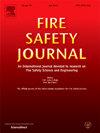基于PMMA光谱荧光特征的热解前沿跟踪
IF 3.3
3区 工程技术
Q2 ENGINEERING, CIVIL
引用次数: 0
摘要
跟踪固体燃料热解前沿的进展的能力在许多应用中是必不可少的,例如火焰传播的研究。在火焰向上扩散等情况下,由于发光火焰的阻碍,跟踪热解前沿变得越来越困难。本研究确定了聚甲基丙烯酸甲酯(PMMA)在火焰蔓延过程中在热解区发生的光致荧光现象,并展示了其在明确识别热解前沿中的应用。PMMA荧光是通过使用266nm, 395nm和450nm光(相干激光和LED光源)激发实现的。荧光响应通过紫外可见光谱进行表征。在266或395 nm的光激发下,热解的PMMA提供了一个荧光特征,在~ 532 nm处有一个强峰,宽度为~ 160 nm。可视化和跟踪热解区域的能力证明了向下和向上火焰蔓延。对于向下传播,发现荧光发生在火焰前缘1毫米内。向上火焰传播实验表明,通过对发光火焰的遮挡,可以检测到热解荧光,实现热解前沿跟踪,同时通过化学发光成像跟踪火焰前沿。本文章由计算机程序翻译,如有差异,请以英文原文为准。
Pyrolysis front tracking using the spectral fluorescence signature of PMMA
The ability to track the progression of a pyrolysis front on a solid fuel is essential in many applications such as the study of flame spread. Tracking the pyrolysis front in cases such as upwards flame spread becomes increasingly difficult due to the obstruction of the luminous flame. This work identifies the occurrence of light-induced fluorescence in the pyrolysis region of polymethyl methacrylate (PMMA) during flame spread and demonstrates its use in explicitly identifying the pyrolysis front. PMMA fluorescence is achieved through excitation using 266 nm, 395 nm, and 450 nm light (both coherent laser and LED sources). The fluorescence response was characterized through UV–VIS spectroscopy. Pyrolyzed PMMA excited with 266 or 395 nm light provided a fluorescence signature with a strong peak at ∼532 nm and a half width of ∼160 nm. The ability to visualize and track the pyrolysis region is demonstrated for both downwards and upwards flame spread. For downward spread, the onset of fluorescence was found to occur within 1 mm of the leading edge of the flame. Upward flame spread experiments demonstrated that pyrolysis fluorescence can be detected through the obscuration of the luminous flame, allowing for pyrolysis front tracking while simultaneously tracking the flame front through chemiluminescence imaging.
求助全文
通过发布文献求助,成功后即可免费获取论文全文。
去求助
来源期刊

Fire Safety Journal
工程技术-材料科学:综合
CiteScore
5.70
自引率
9.70%
发文量
153
审稿时长
60 days
期刊介绍:
Fire Safety Journal is the leading publication dealing with all aspects of fire safety engineering. Its scope is purposefully wide, as it is deemed important to encourage papers from all sources within this multidisciplinary subject, thus providing a forum for its further development as a distinct engineering discipline. This is an essential step towards gaining a status equal to that enjoyed by the other engineering disciplines.
 求助内容:
求助内容: 应助结果提醒方式:
应助结果提醒方式:


